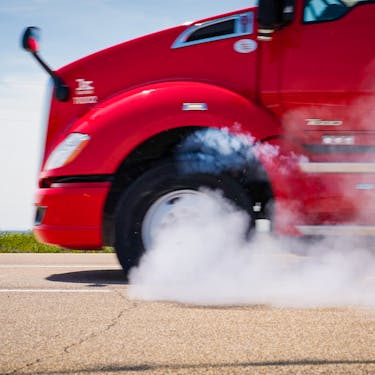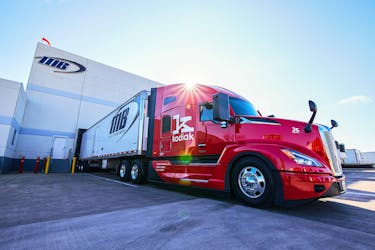Tire blowouts: they happen, we can handle them
|

“But can you handle a blown tire?”
It’s no surprise that how we handle a tire blowout is probably the safety-related question we get the most. Our investors want to know, partners want to know, competitors want to know, and everyday highway drivers definitely want to know.
Tire blowouts are among the most sudden and dangerous events that can happen when driving: anyone who has ever blown a tire on the road can tell you how scary and dangerous it can be. In fact, the Federal Motor Carrier Safety Administration estimates that tire problems were responsible for approximately 15% of truck-related crashes.
As we develop our self-driving system, the kodiakDriver, we wanted to demonstrate that we can handle the bad things that can happen in real-world driving, and tire blowouts are usually the first safety risk in mind.
For all you non-Commercial Driver’s License-holders out there, a tire blowout is a big deal, even when the vehicle you’re driving has 18 of them. On a big rig truck, the back 16 tires are paired dual tires while all the steering is done by the two front single tires, called the steer tires. Steer tires are responsible for steering, handling, and ensuring a steady ride for humans and cargo alike. If one of the back 16 tires pops, a dual tire is able to compensate and carry some weight until the truck comes to a stop; however, if one of the single steer tires pop, it’s a whole different story.
As for all the CDL-holders, you already know that the first step towards handling complex, catastrophic situations like tire blowouts is making a quick determination that a failure has occurred, then fighting to remain in control, and eventually safely pulling over to the side of the road. Trucks with popped tires travel erratically and unpredictably, with unexpected and unknown vehicle dynamics. Even if the tire just goes flat, you can’t maintain speed. This will potentially lead the truck to aggressively veering. The rubber may be stripped from the tire, forcing the vehicle to drive on a bare metal rim. In a worst-case scenario, the truck may swerve, jackknife, or even roll over. Once a truck suffers a steer tire blowout, it behaves like an entirely different truck.
That’s why we’re so excited today to become the first self-driving trucking company to demonstrate that we can maintain complete control of the truck even after suffering a catastrophic tire blowout. As shown in the video below, the kodiakDriver can stay in control of a truck and bring it to a safe and complete stop even when rolling over a giant spike and instantaneously popping a steer tire. The kodiakDriver was able to maintain such precise control that the vehicle never left the lane, stopping in the planned path.
So, to everyone asking the question, the answer is, “Yes. We have tested. And yes, the kodiakDriver can handle tire blowouts better than the average human driver.”
Proving the kodiakDriver remains in control
Of course, it took a lot of work to get us to this moment. In other words, we walked on a flat tire before we ran. Over the past year, we’ve worked to develop and execute tests to ensure that the kodiakDriver could handle the challenge of a blowout.
We started by testing the steering controller’s performance at different tire pressures to understand the system’s control performance at low tire pressures. With this data, we could optimize the kodiakDriver for the changes that occur after a tire blowout.
Once we incorporated the findings from our low-tire pressure tests into the kodiakDriver’s control algorithms, it was time to test with a completely deflated tire flopping off the rim. (Kids, don’t try this at home: you risk damaging your vehicle.) This test allowed us to confirm that the controller can still steer the truck with a completely deflated tire, laying the groundwork for a spontaneous blowout.
After deliberate testing at different tire pressures, we were ready to demonstrate a sudden tire blowout. Executing this test is more complex than you’d think: the vehicle needs to race down the test track and squarely hit a puncture rig, which is a spike mounted to a metal plate. For a human, the precision needed to consistently hit the puncture rig is higher than you’d think. Thankfully, the kodiakDriver is a much more precise driver than a human and remains dead center in a lane unless it needs to nudge over to one side or another. With this consistency, our team was easily able to identify where the kodiakDriver would pass on specific sections of the test rack and place the puncture rig accordingly.
Finally, we were ready to demonstrate a tire blowout with a full tractor and trailer. No holding back! We engaged the kodiakDriver on a test track with a trailer, rolled over the puncture rig, and popped the steer tire. In this case, we chose to stop-in-lane to demonstrate the kodiakDriver’s precision and control. If the kodiakDriver suffered a blowout while operating on highways, its fallback plan would bring the truck to a stop on the shoulder. But with that comes dragging bare metal on pavement, not something recommended on test tracks.
The kodiakDriver’s performance exceeded our high expectations: immediately after being punctured, the left steer tire was completely deflated, and the truck moved less than 6 inches from the center of the lane, while the kodiakDriver instantly countered the force of the truck (that’s a deviation of less than the height of an iPhone Pro Max). As the kodiakDriver quickly brings the truck to a safe stop, it recenters itself, coming to rest only 3.1 inches from dead center.
After our first successful demonstration, we replaced the popped tire, reset the puncture rig, and ran it back again. And again. And again. And again. And again…after all, we have to check for consistent results. Lots of fun, and all in the name of safety.
Building the world’s safest driver.
Preparing an autonomous truck for real-world deployment means being ready to handle the rigors of real-world trucking. We can’t control the hazards trucks will face on the open road, but we can control how the trucks behave when a critical situation occurs. Demonstrating the safety of an autonomous vehicle is about building confidence in how the system behaves in the most complex scenarios and ensuring that the system can always maintain safety and control over a vehicle, even in scenarios where a human may lose control. By demonstrating that the kodiakDriver can consistently maintain complete control even after a major tire blowout, we’re showing the world just how safe a driver the kodiakDriver is.

